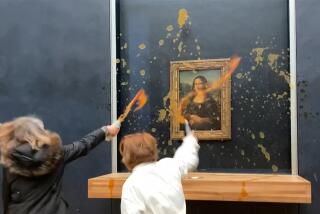Once again the temporary’s so contemporary
- Share via
SOME curious news, with images to match, began bouncing around the Internet last month: A Paris firm called Serero Architects had been chosen to design a temporary viewing platform for the Eiffel Tower, to mark the landmark’s 120th birthday next year. Online, a few commentators complained that the mushroom-shaped platform would ruin the tower’s tapered profile. Others pointed out that the original structure was never meant to be permanent anyway.
That back-and-forth soon came to a quick halt: Word came from Eiffel Tower officials announced that they’d be building no such addition, temporary or otherwise. It was less a hoax than a Web-fueled misunderstanding. Serero Architects, it turned out, had decided on its own to produce the design for a platform; after the firm posted images on its website, bloggers and news outlets began re-posting them, suggesting that the project was actually in the works. It was a story about temporary architecture that was itself temporary, written in the HTML version of invisible ink.
If nothing else, the timing was perfect. Architecture has entered another of its periodic bouts of fascination with impermanence. Maybe it’s the anxiety produced by doomsday predictions about the state of the environment and, lately, the economy. Maybe it’s the quicksilver quality of digital culture, closer in character to sand or water than bricks and mortar. Whatever the source, architects are playing up the idea of temporariness, and even finding solace in it, to a degree not seen since the 1960s and ‘70s, when several experimental design teams explored what Peter Cook, a member of London’s Archigram, called “expendability” and “throwaway architecture.”
Japan’s Shigeru Ban has made a career out of the ephemeral, crafting emergency shelters from cardboard tubes and movable art galleries from stacked shipping containers. Architecture students, inspired by advances in biotechnology, are dreaming up buildings with the ability to change shape or even regenerate themselves, adding a room the way a starfish grows a new arm. The Chinese architect Qingyun Ma, dean of the architecture school at USC, has even argued that cities themselves should have “expiration dates.”
As if following Ma’s advice to the letter, two “pop-up” stores have invaded Los Angeles already this year, combining artfully low-end architecture with high-end marketing. First the fashion label Comme des Garcons opened a hidden store downtown, accessible only from an alley near the corner of 4th and Main. (It will stick around till early 2009.) And this weekend New York’s Storefront for Art and Architecture will open a temporary outpost on Sunset Boulevard, moving into the PaperChase Printing building for a five-week run.
Los Angeles, never big on monumentality, has a long history of what might be called vernacular temporary: rows of taco trucks, party tents during Oscar week. Every year thousands of us drive into the desert to take in the pop-up urbanism of the Coachella and Burning Man festivals. The Temporary Powell, a colorful, gregariously ad hoc library at UCLA by Hodgetts and Fung, was a deserved icon of 1990s L.A. architecture. Built in 1992, it was dismantled five years later when seismic work at the original Powell was complete.
The Silver Lake gallery Materials & Applications has become one of the significant architectural patrons in town by sponsoring a series of temporary pavilions in its frontyard. (The latest, by Jimenez Lai, opened this weekend.) That program is matched by similar, if larger, efforts in other cities. Both P.S.1, in New York, and London’s Serpentine Gallery build elaborate pavilions each summer.
Not surprisingly, L.A. architects have been chosen to design quite a few of them. Frank Gehry is handling this year’s Serpentine pavilion, a pile of glass canopies and timber framing that recalls his most unconventional pre-computer work.
Los Angeles frequently experiences the flip side of these themes, watching as makeshift structures become permanent. The Hollywood sign and certain parking garages fall into that category. So, famously, does Gehry’s Temporary Contemporary, a downtown warehouse that the architect reimagined for the Museum of Contemporary Art in 1983, while its official new home was under construction up on Bunker Hill.
The project was such a hit that the museum never shut it down, ultimately changing its name to the Geffen Contemporary. That made it perhaps the ultimate example of this city’s paradoxical relationship with the temporary. Gehry’s design was so fitting for a city that thrives on flux that we decided to keep it around indefinitely.
It also seems emblematic, as it slides into an odd middle age, of the larger uncertainties and opportunities that define contemporary culture. Consider this article. If you’re reading it online, it may seem entirely provisional -- a mouse click away from oblivion -- while the print version has physical presence. Right?
But while paper yellows and then decays -- and while the newspaper industry continues its awkward, slow-motion divorce from print -- a digital copy can exist in eternally mint condition.
It is that overlay of the fleeting and the indestructible, more than any other single quality, that marks the digital age. Our institutions may these days seem to be built of sand; but a pile of sand, haphazardly or artfully arranged, will outlast any tower -- including that one in Paris.
--
More to Read
The biggest entertainment stories
Get our big stories about Hollywood, film, television, music, arts, culture and more right in your inbox as soon as they publish.
You may occasionally receive promotional content from the Los Angeles Times.











